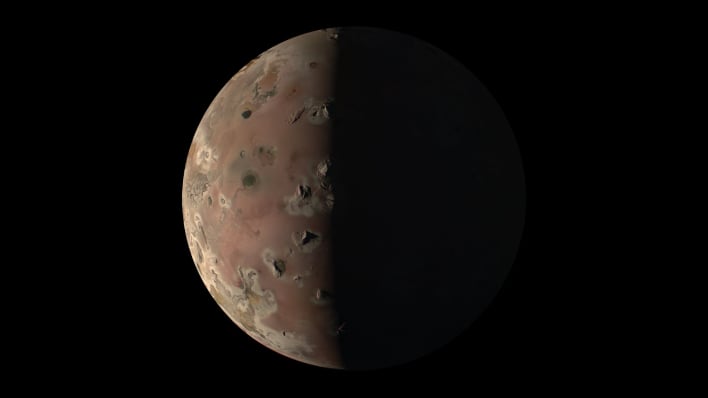NASA’s Juno Spacecraft Buzzes Jupiter’s Volcanic Moon And Snaps Stunning Photos

During its flyby, the JunoCam instrument aboard the Juno spacecraft captured six images of Jupiter’s moon lo on December 30, 2023. NASA first shared a black-and-white image (see below) on X/Twitter, before sharing six color processed images on its website, one of which NASA also shared on its X/Twitter account (see above). The Juno spacecraft is expected to make another close flyby on February 3, 2024, in which the orbiter will once again come within 930 miles of the volcanic surface. NASA researchers are hoping to gain a better understanding of how lo’s volcanoes vary after combing previous observations with the latest data collected by the Juno spacecraft.
“We are looking for how often they erupt, how bright and hot they are, how the shape of the lava flow changes, and how lo’s activity is connected to the flow of charged particles in Jupiter’s magnetosphere,” remarked Juno’s principal investigator, Scott Bolton. “With our pair of close flybys in December and February, Juno will investigate the source of lo’s massive volcanic activity, whether a magma ocean exists underneath its crust, and the importance of tidal forces from Jupiter, which are relentlessly squeezing this tortured moon.”
NASA reported that all three of Juno’s cameras were active during the lo flyby. One was the Jovian Infrared Auroral Mapper (JIRAM), which collected the heat signatures emitted by volcanoes and calderas. The second was the Stellar Reference Unit, which is a navigational star camera, which obtained the highest-resolution images of the surface to date. The third camera was the JunoCam imager which took visible-light color images.
The spacecraft’s JunoCam was only expected to operate for up to eight flybys of Jupiter. Amazingly, however, the latest flyby of lo marked the spacecraft’s 57th orbit around Jupiter, during which the spacecraft and cameras have been subjected to one of the solar system’s most harsh radiation environments.
The cumulative effects of all that radiation has begun to show on JunoCam over the last few orbits,” remarked Ed Hirst, project manager of Juno at NASA’s Jet Propulsion Laboratory. “Pictures from the last flyby show a reduction in the imager’s dynamic range and the appearance of ‘striping’ noise. Our engineering team has been working on solutions to alleviate the radiation damage to keep the imager going.”
Following the February flyby of moon lo, the Juno spacecraft will carry out a series of occultation experiments to probe Jupiter’s upper atmospheric makeup. NASA will use the upcoming flyby of Jupiter to gain key information on the planet’s shape and interior structure.


